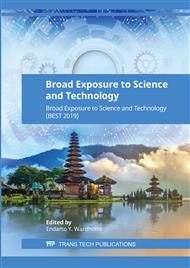p.73
p.80
p.87
p.95
p.101
p.108
p.114
p.122
p.128
Calophyllolide Separation from Calophyllum inophyllum Oil by Silica Gel Adsorption
Abstract:
Nyamplung (Calophyllum inophyllum), widely spreads in Indonesia archipelago, is known to have many advantages. It has various benefits that can be utilized from its root, stem, leaf, and seed. C inophyllum’s seed contains bioactive compounds called calophyllolide. However, the utilization of C. inphyllum’s seed is limited because it contains harmful toxins. Therefore, C. inophyllum’s seed is generally used and investigated as a raw material of biodiesel. This research aimed to find the best condition to isolate calophyllolide, to know the yield of isolated calophyllolide and to know its purity percentage from crude C. inophyllum oil. Current research on calophyllolide is to extract the substance from C. inophyllum’s shell nut without further treatment on it. In this work, calophyllolide was separated from crude C. inophyllum oil by silica gel adsorption. Each fraction obtained was tested qualitatively using Thin Layer Chromatography (TLC) and quantitatively using Gas Chromatography (GC) to analyze calophyllolide mixture. In this study, the best separation method (12.92% purity, 8.03% yield, and 95.02% recovery of calophyllolide) was obtained by using crude C. inophyllum to silica gel mass ratio of 1:2 (g/g).
Info:
Periodical:
Pages:
101-107
Citation:
Online since:
April 2020
Keywords:
Price:
Сopyright:
© 2020 Trans Tech Publications Ltd. All Rights Reserved
Share:
Citation:


